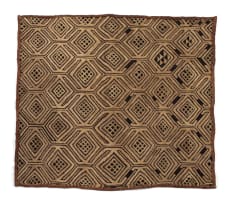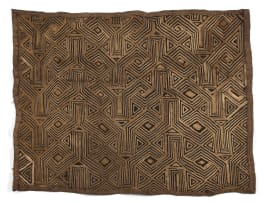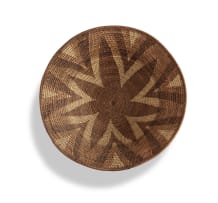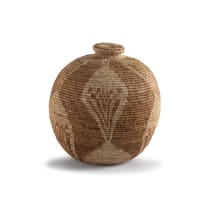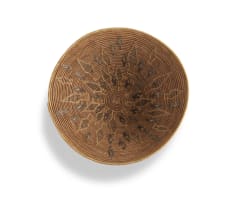Woven Legacies: Innovation & Tradition
Timed Online Auction, 2 - 24 February 2025
Innovation & Tradition
About the Session‘Woven Legacies: Innovation & Tradition’ highlights a diverse range of materials, techniques, and processes from various regions, including Southern, Central and Western Africa. These works coalesce utility, aesthetics and cultural identity. From the tactile threads of textiles to the intricate blending of natural fibres in baskets and the sculptural forms of steel, copper, brass and beads, the concept of weaving is reimagined as a metaphor for connection, storytelling and the passing on of tradition.
About this Item
Notes
The two-dimensional designs of Kuba raffia textiles are recognised as one of the great decorative traditions of Sub-Saharan Africa.1
Raffia textile production is interwoven into Kuba life and society. Skirts and cut-pile cloths are the principle store of wealth and a family will accumulate cloth, as other societies may accumulate cattle or money, so the participation of every adult is expected. For most adults work on textiles is both a part-time activity and part of daily routine. Textile production amongst the Kuba requires the interdependent contributions of men and women. The cultivation of the raffia palm and the weaving of raffia cloth are exclusively a male activity while the fabrication of the skirts is generally done by women. The women's skirts are approximately 5 - 8 meters in length and generally do not have borders. The men's skirts are much longer, consist of different sections and are often completed with a raffia bobble fringe.
Besides being a primary store of wealth raffia cloths have a number of functions. They are worn at special events to indicate a person's position in the social hierachy. They form part of the annual tribute to the Kuba king at the end of the dry season and may form part of a special tax. Cloth also forms part of bride price and skirts and cut-pile fabrics are paid over to the family of the bride.
However, one of the most important uses of cloth is at funerals. At burial the body of the deceased is dressed in a series of raffia textiles, first a plain wrap, then a number of skirts and finally pieces of cut-pile cloth (generally known as Kasaai Velvet or Shoowa Cloth). The raffia fulfills two functions. Firstly, the clan members pay their respects by conferring quality cloth on the deceased. Secondly the traditional dress allows the deceased to be recognised by relatives in ilueeny, the land of the dead.1
- Michael Heuermann
1 Patricia Darish (1996) 'Dressing for the Next Life: Raffia Textile Production and Use among the Kuba of Zäire' Africa Art of a Continent. Munich: Prestel.
Provenance
Michael Heuermann Collection.
View all Unrecorded artist, Kuba Peoples lots for sale in this auction



